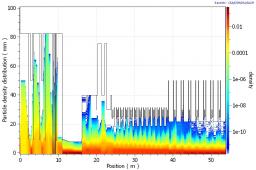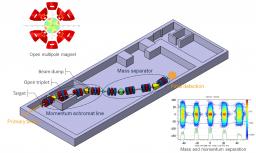With the detailed design phase completed at the end of 2005, the Spiral 2 project has now entered its construction phase. The low-energy ion beam injector, installed at the LPSC in Grenoble, and the proton and deuteron injector currently being installed at the Saclay site, began producing their first beams in 2009. SACM is involved in four aspects of the project: building the Saclay proton and deuteron injector, studying beam dynamics, with a focus on consolidating the accelerator and tuning procedures, building and testing the 12 low-energy cryomodules, and developing the S3 spectrometer.
Injector
The decision to install the low-energy deuteron beamline (LBE2), and the joint ion and deuteron beamline (LBEC) at the Saclay site was taken during the Spiral 2 construction phase, with a view to eventually installing the beamlines at the GANIL facility in Caen. Two bunkers, one for the H+ and D+ ion source, the other housing the injector, were designed and built from existing concrete blocks to contain the neutron flux. This is achieved through the interaction of the deuteron beam with the deuterium contained in the building material.
The deuteron source was first optimized on BETSI, the ion source design and test bench. It benefits from development work carried out by the laboratory on ECR ion sources, namely on a simplified magnetic structure and compact accelerator tube. The Local Safety Committee authorized the startup of the injector at Saclay after examining the safety analysis file.

Result of a study on the Spiral 2 machine's sensitivity to defects. Shown here is the distribution of 300 million particles along the accelerator. This type of data is used to estimate beam loss probabilities, and thus define acceptable amplitudes for the defects studied.
Particle beams
SACM takes part in consolidating the specifications for the Spiral 2 accelerator. Its activities in this area include conducting massive simulations, involving up to a billion particles, to obtain precise beam loss estimations. It supplies simulation codes and their upgrades, and provides access to its computer cluster.
The department is also closely involved in defining, implementing and on-site testing of tuning procedures, as well as developing advanced control command tools, in particular the “virtual machine” program that will make the connection between the control command and the simulation codes.
The two injector lines currently in operation are used to validate adjustment procedures and compare simulations with observations. SACM takes part in the measurement campaigns carried out in Grenoble, and conducts campaigns at Saclay aimed at acquiring the knowledge required to ensure that the accelerator is up and running quickly once the lines are installed at the GANIL facility in 2011.
Low-beta cryomodules
The Spiral 2 superconducting linear accelerator will include two types of cryomodules, comprising cavities with optimized geometry for accelerating particles to 7% the speed of light (for low-beta cavities: b = 0.07) and 12% the speed of light (for high-beta cavities: b = 0.12). SACM is responsible for the development, construction, and testing of the 12 low-beta cryomodules, and for delivering them to the GANIL site.
Each cryomodule includes a cavity equipped with an RF power coupler designed to inject the 10 kW required for this type of cryomodule to operate. These couplers are supplied by the LPSC in Grenoble. A mechanical system is used to adjust the cavity frequency at 4 K through deformation of the cavity walls at extremely high resolution (to within a few nanometers) and over a wide amplitude (2 millimeters). Cryogenic circuits are used in conjunction with a thermal shield and multilayer superinsulation to cool the cavity to 4 K.
Before starting series production of the cryomodules, a qualification model was built. The first tests at 4 K were carried out in December 2008, reaching 10 kW maximum RF power. Cavity and cryostat series-production contracts were notified in 2009, with deliveries scheduled for the summer 2010. The cryomodule assembly and testing phases take place at Saclay until the end of 2011.

Installation of the spectrometer in the S3 experimental area. Coils of an open superconducting multipole (top left) and the final focusing plan (bottom right).
S3 spectrometer
The S3 spectrometer, or Super Separator Spectrometer, will be used by one of the first Spiral 2 experiments at the GANIL facility. It will use stable ion beams produced by the superconducting linac to study the synthesis and spectroscopy of super-heavy elements, mirror nuclei (N = Z) and transfer reactions in light nuclei.
SACM is involved in the spectrometer definition phase. The spectrometer will occupy a floor area of 26 m x 12 m. A primary beam rejection rate of 1013 must be achieved. Large aperture magnets are needed to transmit the secondary beams that have large angle, energy, and charge-state distributions.
The S3 is divided into two separation stages. The first is a momentum achromat, achieved with two magnetic dipoles, which separates the reaction products from the primary beam. The second is a mass separator, made with an electric dipole and a magnetic dipole, used for identification of the nuclei of interest. Focusing is performed by quadrupole triplets. The high momentum acceptance (± 7%) and charge acceptance (± 10%) calls for chromatic correction using sextupoles, moreover the required mass resolution (1/300) implies the use of octupoles to correct higher-order aberrations. Due to available space constraints, these correctors must be built into the quadrupoles.
After the first dipole of the momentum achromat, the primary beam is no longer within the spectrometer momentum acceptance. Therefore, the magnets located right after this dipole must be open in the median plane to allow primary beam extraction. SACM has studied both superconducting and conventional solutions for these magnets, and carried out transport simulations to demonstrate that the required separation is still achieved.
• Accelerator physics and technology › High-Intensity sources and injectors
